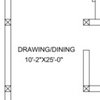My mother told me to use vinegar on my marble shower to clean it. Well now it's dull and awful! What can I use to restore it's shine and what should I use to clean my black marble with in the future?? Help please

Marble Polishing, Stone Restoration · More Info 


Marble Doctors LLC